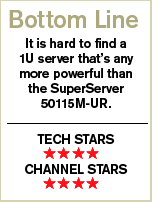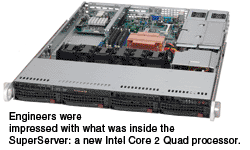Review: Big Power In A Small Box

They are relatively inexpensive, easy to service and easily adaptable for all sizes of clients. SMBs might typically need just one or two 1U servers, while enterprises can continuously add new units as computing needs increase.
Server and motherboard vendor Supermicro is trying to capitalize on this trend with its SuperServer 5015M-UR, a unit that includes impressive processing power and phenomenal performance.

The SuperServer 5015M-UR is quite typical of 1U servers on the outside. The unit measures 17.2 inches wide (slightly narrower than most of its peers), 1.7 inches high and 25.6 inches deep. It weighs 40 pounds and is available in silver or black.
While the SuperServer 5015M-UR might look like other 1U servers on the outside, it's what was inside the sample unit that impressed CRN Test Center engineers most. The unit contained one of the new Intel Core 2 Quad processors running at 2.66GHz with an 8-Mbyte cache. This is an amazingly powerful processor, especially considering the size of the server that it's installed in. It was also loaded with 4 Gbytes of unbuffered DDR2 SDRAM, although its eight DIMM slots will accept a maximum of 8 Gbytes of memory.
The SuperServer 5015M-UR was benchmarked using PerformanceTest software from PassMark. The server's PassMark rating of 1126.1 is among the fastest ever seen by CRN Test Center engineers. In fact, it's almost as fast as a Hewlett-Packard server engineers recently tested that contained two quad-core processors (see CRNtech, Jan. 29).
With its multicore processor, the SuperServer 5015M-UR provides the type of high-performance parallel computing typically done by high-end clustered systems. Multicore processors can work on multiple tasks at once without having the applications compete for processing power. If a quad-core processor is overkill for a customer's needs, the SuperServer 5015M-UR also supports the latest dual-core processors.
The SuperServer 5015M-UR also features a Universal I/O (UIO) card, which provides compatibility with customized storage and networking solutions. The server also supports two standard PCI-Express x8 or x4 expansion cards for a total of three add-on cards. Different riser cards allow the use of three standard PCI-Express cards without the UIO card. Supermicro even managed to squeeze in redundant power: Dual 450-watt power supplies are hearty enough to support any hardware that will fit in the 1U chassis.
The unit affords plenty of storage space via its four 3.5-inch hot-swappable drive bays, which support Serial ATA RAID. The integrated Intel ICH7R SATA controller supports 3-Gbps SATA drives and RAID levels 0, 1, 5 and 10. The sample unit, however, was fitted with a single 36-Gbyte Fujitsu Serial Attached SCSI (SAS) drive driven by an add-on UIO SAS controller card powered by an LSI controller chip. Supermicro also equipped the server with an IPMI 2.0 remote management card. In addition, the server was fitted with a slim DVD-ROM drive and floppy drive. The motherboard has headers for up to four USB connectors, but with the optional floppy drive installed, the server has only two USB ports on the rear end of the chassis. If the floppy drive is not installed, the server can have another two USB ports in front.

Network connectivity is provided to the SuperServer 5015M-UR by way of dual Gigabit Ethernet NICs. Graphics processing is powered by an on-board ATI ES1000 graphics controller with 16 Mbytes of memory, and the server has a single VGA port on the back panel. Other ports include PS/2 keyboard and mouse ports and one serial port. Inside the server, there is room for up to six speed-controlled fans, although only three were needed in the sample unit, which had to expel the heat from only one hard drive not four. All internal components are accessed via a one-piece slide-off hood, and rack-mounting hardware and rails are included with the server.
Supermicro is an easy company for solution providers to work with because its systems are available as bare-bones units or fully populated with hardware. Solution providers only have to add the software that customers want.
The vendor's channel program has three levels. The Gold level is for solution providers with Supermicro sales of $3 million or more per year, while Value-Added Partners must hit Supermicro sales of $1 million per year. Authorized Partners need Supermicro sales of $50,000 per month within six months.
Margins are highly competitive, and MDF is provided based on sales. There are no costs to join the program, and training is free as well. Supermicro offers classroom-based, Web-based and on-site training, along with training sessions at trade shows and road shows. Tech support is free for partners and end users alike. Other benefits include demo units, sales leads from trade shows, seeding programs, rebates, spifs and varying incentives.
A customer's first 1U server purchase is typically just the tip of the iceberg, giving partners the chance to recommend additional hardware and software to complement it. It's likely that the customer also will need a rack for the server, storage and networking hardware, a workstation or two, software, printers and so on. Solution providers also can make some extra revenue by upgrading the server itself with faster processors, more memory, special I/O cards and other options.
With a list price of $3,500 for the configuration reviewed here, partners can build powerful solutions for customers large and small.